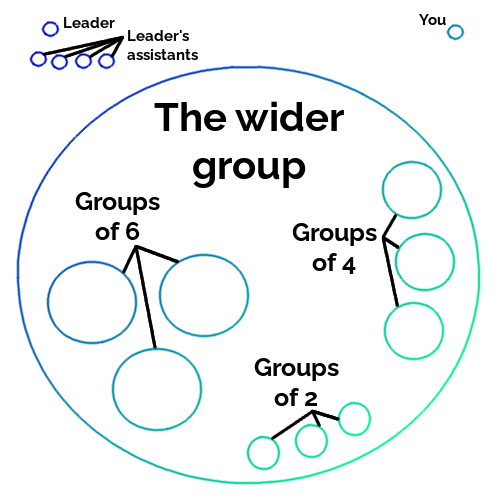How to Get Your Server Lurkers Talking!
A little over two years ago I started a Discord server. I mainly did this because Discord’s a great place to talk with people about their commissions, but I’m not that talkative. In fact, I’m an introvert. Plus I'm generally busy, but being an introvert's a big factor.
When I got to the point of having a large back-catalogue of contacts, I found that people wanted to chat with me every time I logged on, so I figured the logical thing to do would be to give them all a space where they could talk with each other. So, I opened a server and invited them all in.
For a little while it kind of worked. Discussion was slow, but that made sense because these people didn’t know each other, and anyway, there weren’t that many of them. So as I met more people, I issued server invitations to the ones who I thought could contribute meaningfully to group discussion. I waited with baited breath for the bigger numbers to lead naturally to a thriving community.
Spoiler alert: it didn’t happen. In fact, the more people I added – and I passed the 100-person mark a long time ago – the higher a ratio of lurkers to active contributors I seemed to have. It didn’t seem to make sense, least of all because my server’s specifically for people interested in character, species, and worldbuilding work and I was inviting people who were passionate about these things.
For 18 months or so I wondered if this was just how things were going to be: whether there was anything I could do about it, or whether maybe my server was just destined to be one of those quiet ones.
Then I remembered my training!
Enter The Group Imago
Group Imago is a piece of group theory designed to better understand group integration.
Here’s how it works. When you first join a group, the other members of the group are probably strangers to you. You might not even know who the leader is.

So at first all you know is that you’re in a group along with a mass of strangers, plus one person you can immediately differentiate as the leader (and depending on the group, the leader’s assistant if there is one). Your experience at this point looks a bit like figure 1.
The best thing you can do for yourself in this situation is start getting to know people, to essentially tease out little bits of that big group of other members so that you can start to get to know a few of them. Soon, the group starts to look more like figure 2.

Now, here’s the rub. Some people just don’t function well when they have a large group of ‘others’ to get to know. They shut down if “the rest of the group” is too big. After all, when it’s just one big mass of unfamiliar people, where are you supposed to start?
Most of my new members didn’t know, so they just didn’t start at all. Result: one, very quiet group.

It was hardly surprising. The more recently a new person was invited to the group, the bigger “the rest of the group” was, and the more intense the effect felt to them. For my more recent members the group looked like figure 3.
We can’t go doing that to people and expecting them just to get on with it now, can we?
So, how can we facilitate people joining in? We can create smaller groups, and that's what I did.
Group Imago
Here's what I did. First, I created a new category in my server called MINI-GROUPS CORNER along with three new channels. I labelled them:
- 1st group of 2, visible
- 1st group of 4, visible
- 1st group of 6, visible
(Note: I said "1st" because I expected there to be more than one group of each size, and "visible" because later I wanted to experiment with invisible groups.) Then I adjusted their settings so that all of my server members could see them but not post in them. The idea was to create a group structure like you can see in figure 4.

I made a role for each group that, if assigned to a person, would allow them to post in that one particular group. They could still post in the wider group if they wanted, but if they just felt like talking in a small group of 2, 4, or 6, then they had a group where they could do that.
I also made a #welcome-mat channel that only myself and my mod team can post in, wrote a description of what the mini-groups are for, and made a small application form for people to fill in if they want to join a group.
Then I made a #group-applications channel for people to post their form in. The welcome form looks like this:
Project Name: [What's your project? Give the name of your story, game, or even just the name of a character or say 'working on characters'.]
Project Description: [Please keep it short though!]
Any Preference For Group Size?: [You can be in up to 2 groups. Would you prefer to be in the 2-people only group? Is 4 okay with you? Or would you prefer to be in a group of 6?]
Any Preference For Group Visibility?: [Are you happy to be in a visible group or would you rather be in an invisible one?]
Finally, I made an announcement to the whole server to inform all my members of the new changes. Then I sat back and waited for people to respond.
Short-Term Results
Out of a server of 125 people, 12 applied instantly. I assigned the group-specific roles to each person, informed them when I'd done it by pinging them in the group to welcome them in, and used the group's description to keep track of how many people were in that group.
When a group was full, I simply made another one of the same size, plus a role for it. Therefore:
- 1st group of 2
- 1st group of 4
- 1st group of 6
became:
- 1st group of 2
- 2nd group of 2
- 1st group of 4
- 2nd group of 4
- 1st group of 6
- 2nd group of 6
I also experimented with offering invisible groups, to see if the really shy lurkers might prefer that. Personally I found that only one person actively asked for this; everyone else was happy to be seen having their conversations.
I also fielded one complaint from somebody who didn't want me to use the word introvert to describe the people who might use these groups, so from then on I avoided using 'the i word'.
Longer-Term Results
"But Hayley," I see you write. (Thank you for spelling my name right, by the way, that's impeccable of you!) "Wouldn't this arrangement cause rifts between people?"
No, actually, it hasn't. In fact, Group Imago theory took hold and my mini-group participants graduated from using their allotted groups to posting in the wider group.
Use of the mini-groups fluctuates, but whenever my mini-group participants feel like reverting to a smaller group of people who they know better, they use their mini-group for a few days before returning to the wider group once again.
Ongoing Maintenance
The only ongoing maintenance I do is to do a monthly ping to invite people to switch groups if they want. A small number of people ask publicly to switch just to keep things fresh, while a few asked me privately via Direct Message to move, when they felt their current group was a poor fit.
Aside from that, the only maintenance you will need to do is to make a new group and role when the previous one gets full.
Credits
Berne, E., In treatment, Transactional Analysis Bulletin, 1(2), 10.
Clarkson, P., Group Imago and the Stages of Group Development, Transactional Analysis Journal, Vol. 21, No. 1, January 1991.
Title image by me.


